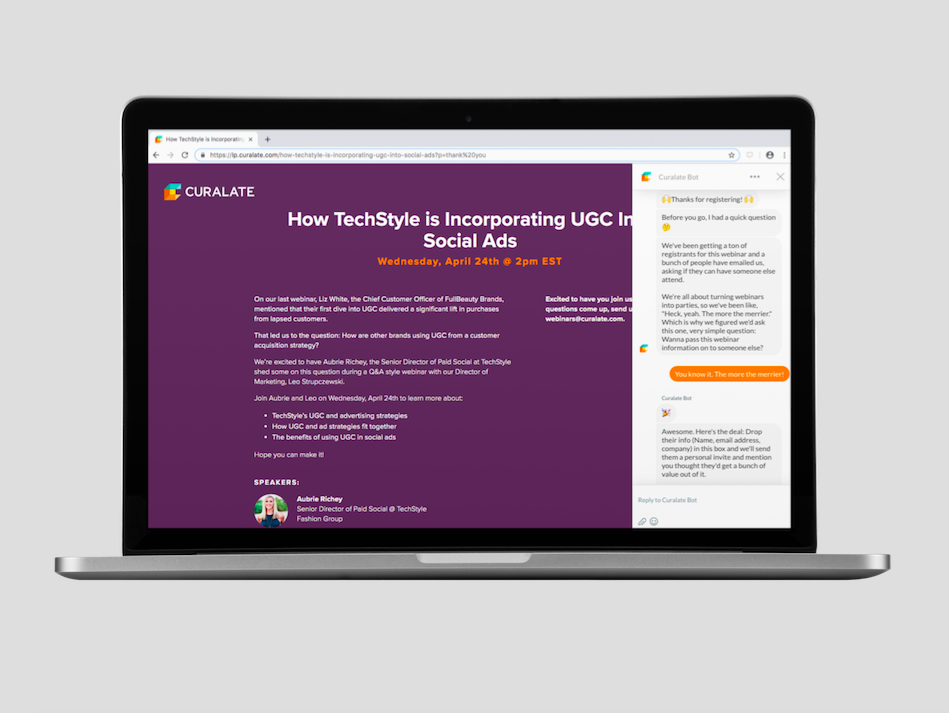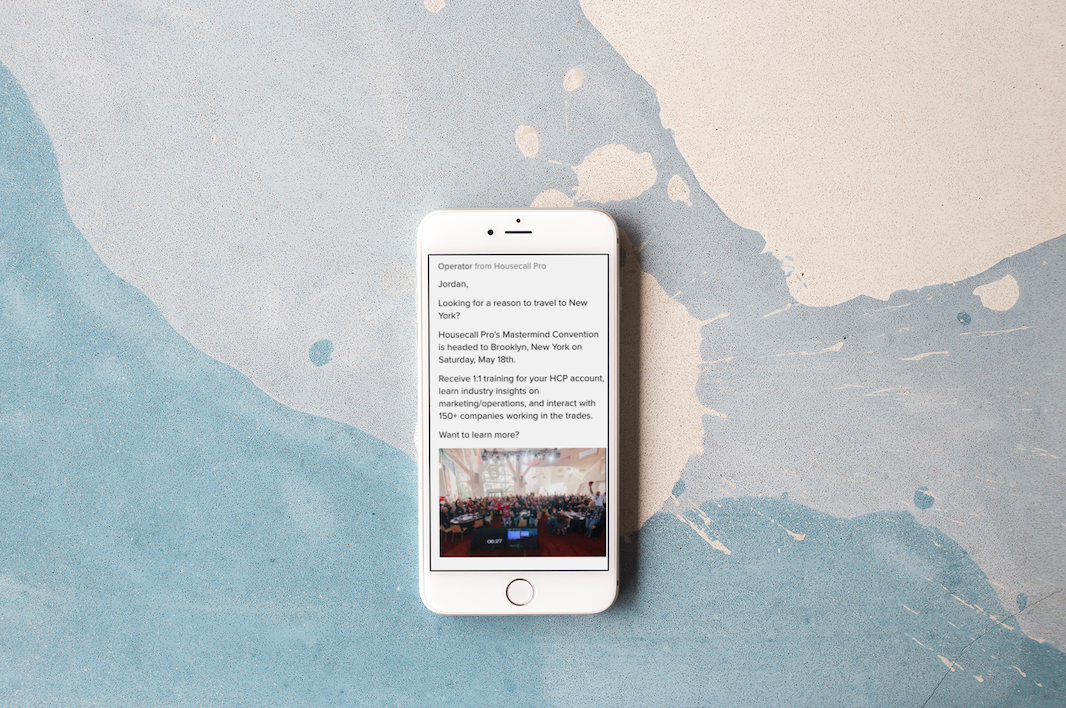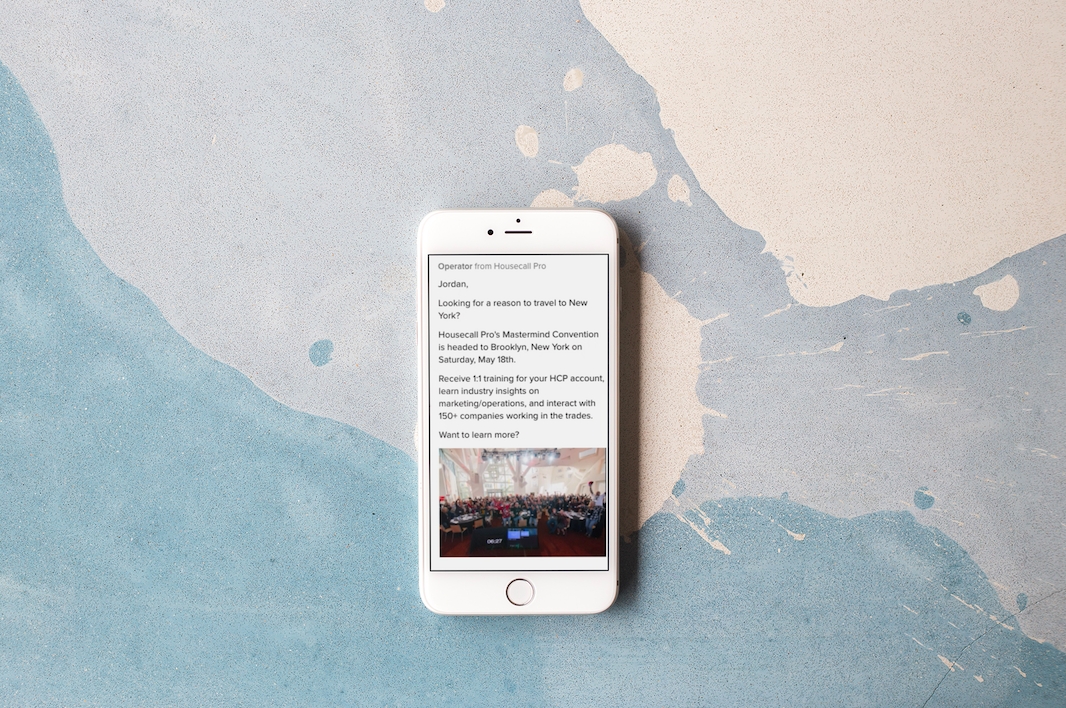Chatbots have become more commonplace in B2B, as buyers expect more conversational engagement with brands. In fact, it can feel rare nowadays to visit a webpage and not be immediately greeted by a chatbot, and industry research shows 15% of buyers have used chatbots to communicate with a business in the past 12 months.
As chatbot adoption continues to grow, B2B brands are not stopping at the homepage and are instead looking to integrate chat into other engagement points throughout the buyer’s journey. Companies such as Curalate and Housecall Pro are advancing their strategies by using chatbots to better capture and qualify leads, as well as incorporating them into their ABM mix.
“Chatbots worked really well in the beginning because they were something new and novel — it was a cool way to be a website visitor,” said Leo Strupczewski, Marketing Director of Curalate, a social commerce platform, in an interview with Demand Gen Report. “The problem is we haven’t, as marketers, evolved in our execution quickly enough to continue to deliver value past that novelty. It’s [often] very formulaic and it’s almost to the level of being predictable. I think as a consumer, we’re developing a bit of banner blindness to chatbots.”
According to Drift’s 2018 State of Chatbots Report, the top challenges buyers face in their online experiences include hard-to-navigate websites (34%), unable to get answers to simple questions (31%) and services take too long to locate (27%). Chatbots can help businesses point customers in the right direction, answer frequently asked questions and more. But industry experts warn that marketers should take care not to confine chatbots to the top of the funnel. When leveraged properly, chatbots can be used to communicate with buyers throughout their journey and ensure online experiences are personalized to each account.
“We know that people visit our websites and try to interact with us outside of our normal business hours,” said Samantha Stone, Founder and CMO of the Marketing Advisory Network, in an interview with Demand Gen Report. “Newer technology allows us to have human-like conversations via chatbot that can happen whenever people are visiting us… [But] we should think of these conversations as happening throughout the buying process and not just to initiate a conversation.”
Chatbots Offer Alternative To Lead Forms, Streamlined Nurture Paths

Chatbots can play a particularly large role in content marketing strategies. Recent research from Demand Gen Report shows buyers are more time-starved than ever — 73% say they have less time to devote to reading and researching and 59% believe content should be easier to access. Chatbots can therefore be used to recommend relevant content and replace lead forms by capturing buyer information in a more conversational, engaging manner.
“Buyers and users are coming to us throughout their journey, many different times. Each time, they look for different types of content,” said Stone. “If we can be smart about not just having that content available, but also having the chat conversation available so we can direct them based on where they are, that can be incredibly powerful.”
Housecall Pro, a field services management provider, has used chatbots since it was founded in 2013. While the company initially deployed Intercom’s chatbots to provide and scale customer support, Roland Ligtenberg, Co-Founder and VP of Growth and Business Development, said chatbots now also play an important role in qualifying leads.
“As potential new leads come through, they get qualified by the bots and routed in the right direction,” said Ligtenberg in an interview with Demand Gen Report. He explained that the bots are programed to capture information such as company industry, size, business value and more. Web visitors can then be routed down several paths and flagged for sales as able to serve themselves, needing some assistance or needing full service. “Depending on how we’ve trained the bot and the [customer’s] lifetime value, we can choose to send them down a certain path.”
Curalate also turns to chatbots to help generate leads and improve its nurture process, although the company has not gotten rid of lead forms completely.
“There’s a lot of discussion about whether chatbots replace forms. To me, I think they work really well in conjunction,” said Strupczewski. “We use chatbots to do the same kind of stuff that we do via form, but in a little more colloquial and every day, conversational way. One of the things I like most about chatbots is that they’re a great way to test messaging and test the questions that you can ask.”
According to Strupczewski, Curalate’s lead forms used to ask for a prospect’s first name, last name, email address, company name and number of employees. But because of the company’s offering as a social commerce platform, Curalate thought the number of Instagram followers may be a better qualifier than the number of employees. To test this theory, Curalate created a Drift chatbot that would respond to demo requests and ask prospects for their Instagram follower count.
“We didn’t want to just go and change the form and we didn’t have any sort of testing software or processes in place,” said Strupczewski. “The goal there was not so much to get the data, but to see how many people were interested in giving us that data. We then used that to inform whether that was a worthwhile question on the form.”
Nearly 65% of people who clicked into the chatbot answered the question, prompting Curalate to switch the lead form to ask for Instagram followers rather than employee headcount. Strupczewski said this simple change has allowed the company to improve its funnel by better qualifying and prioritizing leads.
Accelerating Conversion By Adding Chat To An Account-Based Approach

ABM is repeatedly called a key factor for modern marketing success and was named the top tech priority for demand marketers in 2019. So, it should come as no surprise that marketers are starting to take an account-based approach to their chatbot strategies, as well.
Curalate, for example, wanted to create chatbots that could recognize repeat visitors and generate personalized conversations based on their contact information and previous engagement data. The company beta tested Drift’s new Marketo integration and used it to target webinar registrants who weren’t converting with account-based plays delivered via chatbots.
“We do a really good job of converting demo requests into actual meetings, but our funnel is not perfect,” said Strupczewski. “It’s not 100% and there are a handful [of prospects] that, for whatever reason, we just can’t connect with.”
To address this funnel gap, the company built a smart list in Marketo of marketing qualified leads who had requested a demo but not yet scheduled or taken a meeting with sales. When these prospects revisited the site, they were served a highly targeted message and calendar options to get a meeting scheduled on the spot. Strupczewski said the approach allowed the company to land two scheduled meetings in one week.
“Our best chatbots are the ones that we serve to the least number of people,” said Strupczewski. “My goal for 2019 is to actually drastically reduce the number of people that we serve our chatbots to on our website. I want to stop thinking as much about driving conversations and start thinking a lot more about driving conversations that drive business value. That means getting hyper focused on accounts that we know are the right fit and using Drift to help propel that.”
Housecall Pro has taken a similar approach to drive event attendance. The company uses Intercom’s Custom Bots to create a line of custom chatbots for its user conferences and deploys the bots to qualify website visitors on a region-by-region basis. Qualified leads or customers from the surrounding area are invited to the event and prompted to buy tickets, all within the chatbot.
“Rather than making thousands of outbound calls to all of our customers and inviting them to events, [we] selectively target different regions,” said Ligtenberg. “There’s probably 12 to 24 different routes that any particular probe can take. Essentially, what it’s doing is pre-qualifying them and even pre-selling them.”
Ligtenberg said that the bots have made attracting current customers and prospects to events easier and resulted in over $25,000 in ticket sales for Housecall Pro’s last two events.
As chatbots continue to take over B2B webpages, B2B marketers must be careful not to default to run-of-the-mill strategies and limit their chatbots to simple customer service agents or homepage greeters. Today’s chatbots have a role to play in the entire buyer’s journey and can help businesses deliver the personalized, conversational experiences B2B consumers are starting to expect.
“We have the opportunity to ask brilliant, deep questions that are going to help us 1) direct [customers] to the right resources and 2) help us understand them as an individual, so that when we follow up, we can be really effective,” said Stone.







